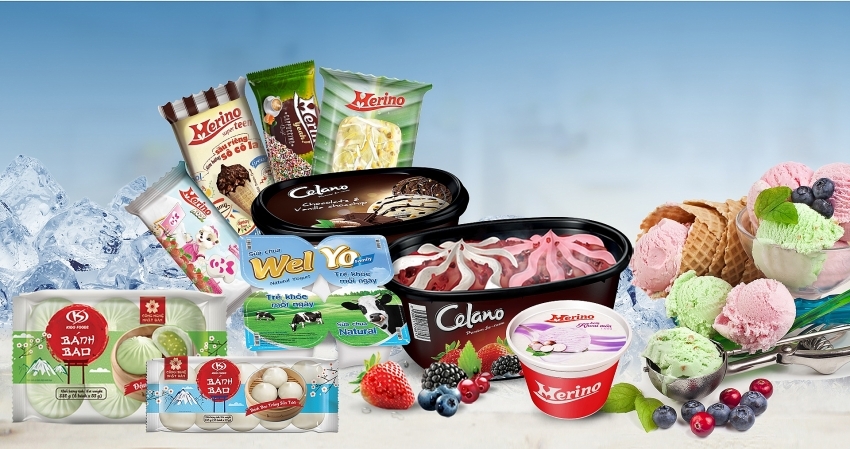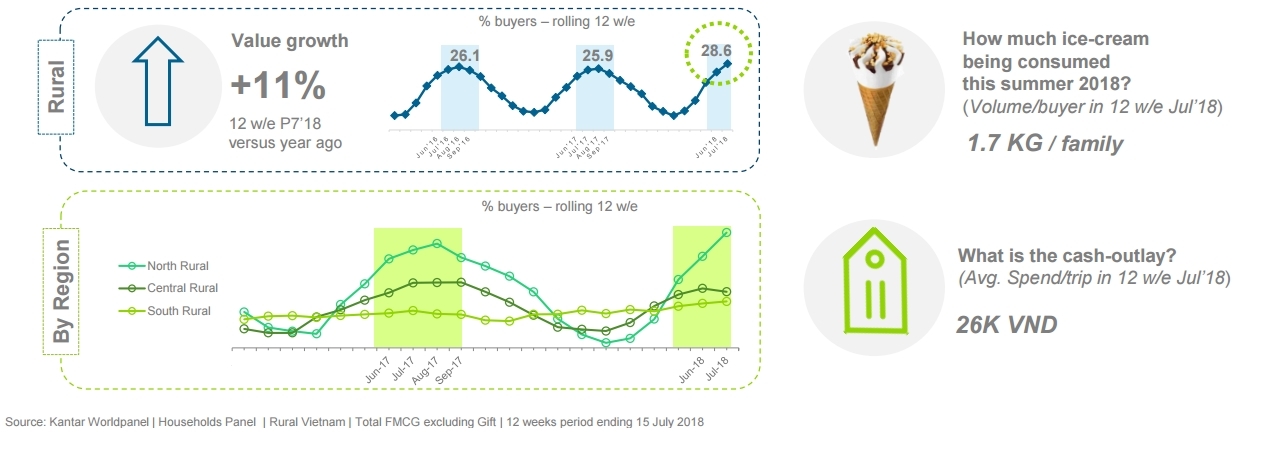 |
| New players and new flavours heat up the icy competition in Vietnam (photo: Kido) |
Demand is so high that vendors are usually sold out even with the price of VND50,000-60,000 ($2.2-2.6) per ice cream bar.
According to statistics from Statista.com, revenue in the ice-cream segment is expected to reach $74 million in 2019, with the compound annual growth rate (CAGR) of 7.4 per cent in 2019-2023.
Ice cream is one of the best-performing fast moving consumer goods (FMCG) items.
While FMCG grows at 5.2 per cent in rural Vietnam, ice cream achieved double-digit growth rate and enjoyed the highest reach to end consumers this summer in rural areas. Significant seasonality movements are observed in the central and especially the north where ice-cream penetration reached twice as high as in other regions, according to Kantar Worldpanel.
On the contrary, the research agency found that ice cream is being bought all year round in the southern rural areas and has begun penetrating even more households in 2018. As a result, consumers display different shopping habits and preferences in each region. A cell–approach strategy with relevant consumer insight is needed in order to capture this short-term sales push opportunity.
Although the growth of the ice-cream market exceeds many other industries, the competition has also become more intense. According to data until 2017, two domestic ice cream firms Kido Food and Vinamilk hold nearly 50 per cent of the ice cream market. Unilever Vietnam with Cornetto products holds 6.1 per cent, ranking third.
In 2018, the revenue of the ice cream sector decreased by 12.3 per cent while that of the yoghurt segment decreased by 32.3 per cent due to fierce competition, which is the main reason that Kido Food's sales in 2018 decreased by 15.7 per cent on-year, reaching only VND1.3 trillion ($56.52 million).
The same situation happened in Thuy Ta, Hanoi's oldest ice cream company, where ice cream sales fell by 3.1 per cent compared to 2017, earning nearly VND46 billion ($2 million)in revenue.
At the ice cream industry, good product quality and a strong distribution system are two keys for success. The entry of foreign ice cream firms importing goods from countries with which Vietnam has signed new FTAs of higher benefits, together with support from many foreign supermarkets in distribution or the development of online distribution networks can make the race in the ice cream market “hotter”.
It is still early to assess the attraction of expensive brown sugar bubble ice cream as the summer season has just begun. However, new products can significantly change a company's revenue structure.
The report of market research firm Euromonitor said that thanks to its sweet taste and influence of Japanese culture, green tea ice cream has become popular, rising from the seventh in 2013 to the fourth position among the most popular ice cream flavours, only after chocolate, vanilla, and strawberry since 2015. Many big businesses in 2016 added this flavour to their product portfolio such as Vinamilk (Twin Cows) or Nestlé Vietnam (Kit Kat Green Tea).
Many ice cream firms need to diversify products to maintain and expand their market share. Domestic ice cream firms can create new products, find ways to combine new flavours, or follow new global trends that are becoming popular among Vietnamese consumers.
In 2018, Vinamilk introduced the Yolo cream product. Kido Food has not launched a new product, but its list of ice creams has grown longer with banana cream, fish ice cream, or mochi ice cream.
 |
Brown sugar bubble ice cream is the new flavour Vietnamese consumers look for. Source: kenh14.vn
Brown sugar bubble ice cream is welcomed in Vietnam just as bubble tea – the other Taiwanese craze – was by young people, with a great number of customers looking to purchase them on Facebook and other social networks.
The entry of foreign ice cream firms is clearly enriching the choices of consumers.
Current distribution channels in the ice cream industry are convenience stores, supermarkets, and hypermarkets.
Kido Group still holds the lead in ice cream distribution, maintaining 70,000 retail points. Some new ice cream firms like TH True Milk have also been expanding quite quickly.
Although only entering the ice cream industry in the middle of 2018, TH True Ice Cream is currently distributed at a number of supermarkets and more than 200 retail stores specialising in the products of this dairy ecosystem.
Foreign ice cream firms have also increased their presence in supermarkets and more and more foreign convenience chains are present in Vietnam. Baskin-Robbins, a chain of ice cream shops from the US is now open in eight provinces and cities with 35 stores. VIR
Tan Duong

I scream for ice cream!
Feeling a little hot under the collar as summer arrives? Don't worry, here's the tastiest way to cool down! Have you tried an ice cream at one of Hanoi's oldest ice cream parlours?
 Not much after going on sale in Taiwan, brown sugar bubble ice cream has been selling through online shops in Vietnam since May.
Not much after going on sale in Taiwan, brown sugar bubble ice cream has been selling through online shops in Vietnam since May.